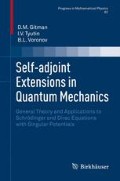Abstract
We present the basics of the general spectral theory of self-adjoint operators and its application to the spectral analysis of self-adjoint ordinary differential operators. In finding spectrum and inversion formulas (eigenfunction expansion), we follow the Krein method of guiding functionals.
Access this chapter
Tax calculation will be finalised at checkout
Purchases are for personal use only
Notes
- 1.
- 2.
Another name is “an (operator) spectral function.”
- 3.
Another name is “cyclic vector.”
- 4.
Nondegenerate in physics terminology.
- 5.
In the physics literature, the term “degenerate spectrum” is conventionaly used.
- 6.
Which is determined by the rank of the matrix σ ij (λ).
- 7.
We recall that coefficients of even s.a. differential operations are real-valued.
- 8.
An operator \(\hat{f}\) is called real if ξ ∈ D f implies that \(\overline{\xi } \in {D}_{f}\) and \(\hat{f}\xi = \eta \) implies that \(\hat{f}\overline{\xi } = \overline{\eta }\).
- 9.
The spectral function generally can contain the so-called singular, or singular continuous, term; see [97]. Such terms are absent in all the cases encountered in this book.
- 10.
In such a situation, the functions u j (x; λ) are conventionally called the generalized eigenfunctions of the operator \(\hat{f}\).
- 11.
For some λ, it may be less than m.
- 12.
For the continuous spectrum, these relations are symbolic in a sense.
- 13.
Treated in the sense of distributions.
- 14.
That is, the potential can be singular only at the endpoints of the interval.
- 15.
We note that possible mixed s.a. boundary conditions, like periodic ones, are beyond the scope of our consideration in this section, although such boundary conditions can yield a simple spectrum.
- 16.
Which is sufficient if the functional proves to be simple.
- 17.
- 18.
We note that a preliminary estimate of the asymptotic behavior of the function ψ (5.41) at the left endpoint a may be sufficient to assert that ψ ∈ L 2(a, b).
- 19.
This is the case in which p + (a) = p − (a) = 0, i.e., the left a.b. coefficients are equal to zero.
- 20.
This is the case in which p + (a) = p − (a) = 1.
- 21.
The constant κ0 is of dimension of inverse length, so that κ0δ is dimensionless.
- 22.
This is the case in which p + (a) = p − (a) = 1.
- 23.
By the function U(x; z), we here mean the specific function U for each operator \(\hat{{f}}_{\mathfrak e}\).
- 24.
Namely, for μ > 1 ∕ 2 and ν≠ ± π ∕ 2.
References
Abramowitz, M., Stegun, I. (eds.): Handbook of Mathematical Functions. National Bureau of Standards, New York (1964)
Adami, R., Teta, A.: On the Aharonov–Bohm effect. Lett. Math. Phys. 43, 43–54 (1998)
Akhiezer, N.I., Glazman, I.M.: Theory of Linear Operators in Hilbert Space. Pitman, Boston (1981)
Berezansky, Yu.M.: Eigenfunction Expansions Associated with Self-adjoint Operators. Naukova Dumka, Kiev (1965)
Berezin, F.A., Shubin, M.A.: Schrödinger Equation. Kluwer, New York (1991)
Cycon, H.L., Froese, R.G., Kirsch, W., Simon, B.: Schrödinger Operators—with Applications to Quantum Mechanics and Global Geometry. Springer, Berlin (1987)
Gelfand, I.M., Kostyuchenko, A.G.: Eigenfunction expansions for differential and other operators. Dokl. Akad. Nauk SSSR 103(3) 349–352 (1955)
Gelfand, I.M., Shilov, G.E.: Some problems of the theory of differential equations. Generalized functions, part 3. Fizmatgiz, Moscow (1958)
Hislop, P.D., Sigal, I.M.: Introduction to Spectral Theory: With Applications to Schrödinger Operators. Appl. Math. Sci. Springer (1995)
Jörgens, K., Weidmann, J.: Spectral Properties of Hamiltonian Operators. Lecture Notes in Mathematics. Springer, Berlin (1973)
Kolmogorov, A.N., Fomin, S.V.: Elements of Function Theory and Functional Analysis. Nauka, Moskva (1976)
Krein, M.T.: A general method for decomposition of positively defined kernels into elementary products. Dokl. Akad. Nauk SSSR 53, 3–6 (1946) (in Russian); On Hermitian operators with guiding functionals. Zbirnik Prazc’ Institutu Matematiki, AN URSR No.10 83–105 (1948) (in Ukranian)
Levitan, B.M.: Eigenfunction Expansions Assosiated with Second-order Differential Equations. Gostechizdat, Moscow (1950) (in Russian)
Naimark, M.A.: Linear differential operators. Nauka, Moskva (1959) (in Russian). F. Ungar Pub. Co. New York (1967)
Reed, M., Simon, B.: Methods of Modern Mathematical Physics, vol. II. Harmonic Analysis. Self-adjointness. Academic Press, New York (1975)
Shilov, G.E., Gurevich, B.L.: Integral, measure, and derivative. Nauka, Moscow (1967)
Teschl, G.: Mathematical Methods in Quantum Mechanics: With Applications to Schrödinger Operators. Graduate Studies in Mathematics, 99. American Mathematical Society (2009)
Titchmarsh, E.C.: Eigenfunction Expansions Assosiated with Second-order Differential Equations. Clarendon Press, Oxford (1946)
Titchmarsh, E.C.: Eigenfunction Expansions Assosiated with Second-order Differential Equations. Part II. Clarendon Press, Oxford (1958)
Weyl, H.: Über Gewöhnliche differentialgleichungen mit singularitäten und zugehörigen entwicklungen willkürlicher funktionen. Math. Annal. 68, 220–269 (1910)
Author information
Authors and Affiliations
Rights and permissions
Copyright information
© 2012 Springer Science+Business Media, LLC
About this chapter
Cite this chapter
Gitman, D.M., Tyutin, I.V., Voronov, B.L. (2012). Spectral Analysis of Self-adjoint Operators. In: Self-adjoint Extensions in Quantum Mechanics. Progress in Mathematical Physics, vol 62. Birkhäuser Boston. https://doi.org/10.1007/978-0-8176-4662-2_5
Download citation
DOI: https://doi.org/10.1007/978-0-8176-4662-2_5
Published:
Publisher Name: Birkhäuser Boston
Print ISBN: 978-0-8176-4400-0
Online ISBN: 978-0-8176-4662-2
eBook Packages: Mathematics and StatisticsMathematics and Statistics (R0)

